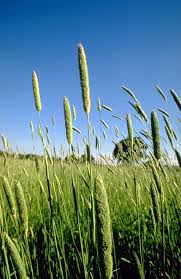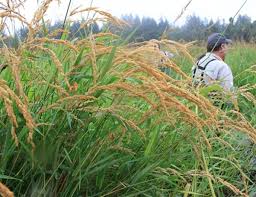Phalaris Grass, scientifically known as Phalaris arundinacea, is a type of grass that grows in many places around the world. It has long, thin leaves and can reach up to 5 feet in height. This grass is often found in wetlands, along the edges of ponds, and in damp areas.
One interesting thing about Phalaris Grass is its unique appearance. The leaves are usually green, but they can sometimes have a bluish or purplish tint. In the summer, it produces small flowers that can be green, yellow, or even purple, adding a touch of color to the landscape.
While Phalaris Grass might look pretty, it’s important to know that it can be invasive. This means that it can spread quickly and take over other plants’ space. Because of this, some people consider it a weed. It’s a good idea to keep an eye on Phalaris Grass if it grows in your yard or garden.
In some places, Phalaris Grass has been used for erosion control. Its strong roots help keep soil in place, preventing it from washing away during heavy rains. Additionally, some animals like to eat Phalaris Grass, so it can provide food and habitat for wildlife.
If you’re thinking about growing Phalaris Grass in your garden, make sure you consider its potential to spread. It’s a good idea to plant it in a container or a controlled area so that it doesn’t take over your entire yard. Remember, while it might look nice, it’s important to be aware of its growth habits.
In addition, Phalaris Grass, or Phalaris arundinacea, is a type of grass with thin leaves and colorful flowers. It can be found in wet areas and is known for its invasive tendencies. While it has its uses, like erosion control and wildlife habitat, it’s important to manage its growth carefully.
Read Also: PawPaw/Papaya Latex: Economic Importance, Uses and By-Products
Growing Phalaris Grass

Here’s a simple growing guide for Phalaris Grass (Phalaris arundinacea):
1. Choosing the Right Location: Phalaris Grass prefers moist and damp areas, so choose a spot in your garden that gets a good amount of sunlight but also retains some moisture. It can tolerate both full sun and partial shade.
2. Soil Preparation: Prepare the soil by loosening it and adding some organic matter, like compost. This will help improve drainage and provide nutrients for the grass to grow.
3. Planting: You can plant Phalaris Grass either from seeds or by dividing existing plants. If using seeds, sow them in early spring or fall, and lightly cover them with soil. Water gently to keep the soil moist until the seeds germinate. If dividing, do so in early spring or late fall.
4. Watering: Keep the soil consistently moist, especially during the growing season. However, make sure the area doesn’t become waterlogged, as this can lead to root rot.
5. Fertilizing: Phalaris Grass doesn’t require heavy fertilization. A balanced, all-purpose fertilizer applied in early spring should be sufficient.
6. Maintenance: Trim back the grass in late winter or early spring to encourage new growth. This is also a good time to remove any dead or damaged foliage. Phalaris Grass can spread quickly, so keep an eye on its growth and trim it back if it starts to take over other plants.
7. Pests and Diseases: Phalaris Grass is generally quite hardy and resistant to pests and diseases. However, keeping the area clean and free from debris can help prevent any potential issues.
8. Invasive Potential: As mentioned earlier, Phalaris Grass can be invasive, so consider planting it in a container or a controlled area to prevent it from spreading too aggressively.
9. Wildlife Benefits: Phalaris Grass can attract various wildlife, including birds and insects. If you want to create a wildlife-friendly garden, it can be a good addition.
10. Harvesting: While Phalaris Grass is not typically grown for harvest, you can cut and dry the grass for decorative purposes, such as in floral arrangements.
Remember, while Phalaris Grass can add beauty to your garden, it’s important to manage its growth to prevent it from becoming invasive. Regular maintenance and monitoring will help you enjoy its benefits without letting it take over your garden
Caring for Phalaris Grass

Here’s a care guide for Phalaris Grass (Phalaris arundinacea):
1. Watering: Phalaris Grass prefers consistently moist soil. Water it regularly, especially during dry spells, to keep the soil from drying out. However, be cautious not to overwater, as waterlogged soil can lead to root problems.
2. Sunlight: Plant Phalaris Grass in a location that receives either full sunlight or partial shade. It can tolerate both, but a balance between sunlight and shade is ideal.
3. Soil: Choose a location with well-draining soil. If the soil is heavy or clay-like, consider amending it with compost to improve drainage.
4. Fertilizing: Phalaris Grass doesn’t need heavy fertilization. Apply a balanced, slow-release fertilizer in the spring to provide necessary nutrients for healthy growth.
5. Pruning: Trim back the grass in late winter or early spring before new growth begins. This helps rejuvenate the plant and keeps it from looking too messy.
6. Invasive Management: Be vigilant about the spread of Phalaris Grass, as it has invasive tendencies. Consider planting it in containers or using barriers to prevent it from taking over other parts of your garden.
7. Pests and Diseases: Phalaris Grass is generally resistant to pests and diseases. However, keeping the area clean and practicing good garden hygiene will help prevent potential issues.
8. Wildlife: Phalaris Grass can attract birds and insects, making it a valuable addition to wildlife-friendly gardens.
Phalaris Grass can be propagated through seeds or by dividing established clumps. If dividing, do so in early spring or late fall for best results.
Remember, while Phalaris Grass can be visually appealing and beneficial for wildlife, it’s important to keep its growth in check to prevent it from becoming a nuisance. Regular care and maintenance will help you enjoy its beauty without letting it become invasive.
Read Also: All You Need To Know About Couch Grass (Elymus Repens)
Benefits and Uses of Phalaris Gras
Here are some benefits and uses of Phalaris Grass (Phalaris arundinacea):
1. Erosion Control: Phalaris Grass has strong, deep roots that help stabilize soil and prevent erosion, making it a valuable plant for controlling soil loss in areas prone to erosion.
2. Wildlife Habitat: The grass provides shelter and habitat for various wildlife, including birds and insects, contributing to a diverse and thriving ecosystem in your garden.
3. Water Filtration: Phalaris Grass can help filter and purify water in wetland areas, aiding in the removal of pollutants and improving water quality.
4. Aesthetic Appeal: With its attractive foliage and colorful flowers, Phalaris Grass can enhance the visual appeal of gardens, landscapes, and floral arrangements.
5. Decorative Use: Dried Phalaris Grass can be used in dried flower arrangements, wreaths, and crafts, adding a natural and rustic touch to indoor decor.
6. Educational Purposes: Phalaris Grass can be used for educational purposes, such as teaching about wetland ecosystems, plant adaptations, and environmental conservation.
7. Naturalization Projects: It can be used in naturalization projects to restore or enhance wetland habitats and create natural and ecologically diverse areas.
8. Livestock Forage (in some cases): While not suitable for all livestock, some animals may graze on Phalaris Grass, providing a potential source of forage in specific situations.
9. Restoration of Degraded Sites: Phalaris Grass can be planted to help restore degraded areas, especially those with poor soil quality or erosion issues.
10. Traditional and Cultural Uses (historical): In the past, Phalaris Grass was sometimes used for traditional purposes, such as weaving, thatching, and crafting.
It’s important to note that while Phalaris Grass has these potential benefits and uses, its invasive nature should be carefully managed to prevent it from spreading uncontrollably and outcompeting native plant species. Always consider local environmental conditions and regulations before introducing Phalaris Grass to a new area.
Read Also: What You Should Know About SWOT Analysis
